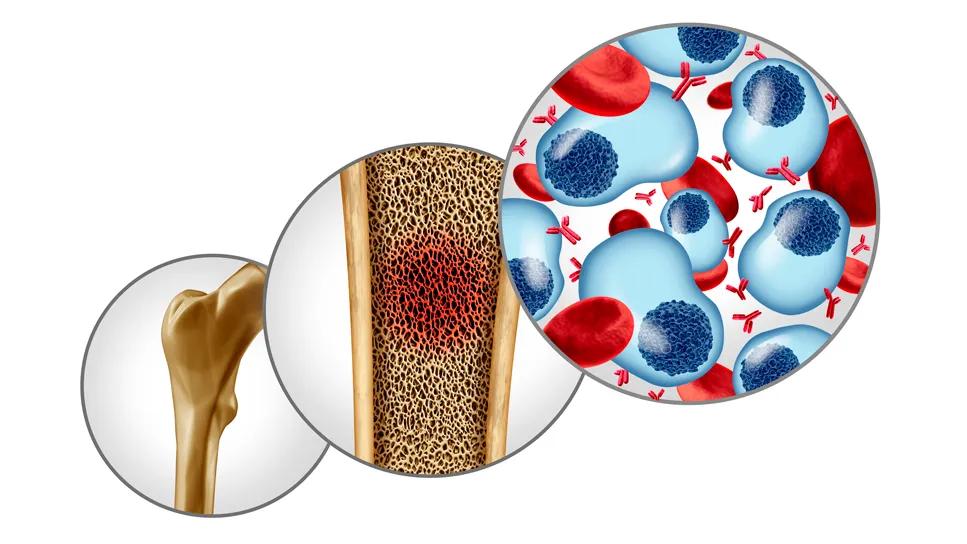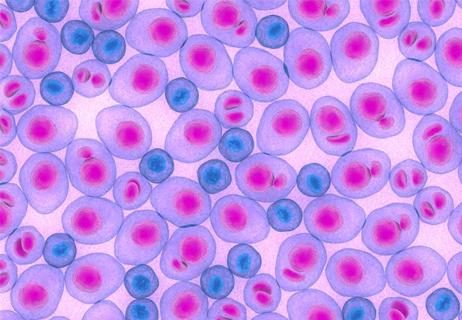Findings from large database important to inform clinical practice

Examination of a large real-world database sheds some light on optimal sequencing and timing of treatments for patients with relapsed/refractory multiple myeloma (RRMM) who have been exposed to BCMA-directed therapy.
The analysis reveals that waiting at least nine months before instituting teclistamab in patients with RRMM exposed to BCMA-directed therapy may improve outcomes.
The data also show that among patients who received prior BCMA-directed therapy, the response to teclistamab is highest in patients who received prior chimeric antigen receptor (CAR) T-cell therapy followed by an antibody drug conjugate and a bispecific antibody as their most recent prior BCMA-directed therapy.
“This is an important study, and although it’s retrospective, the cohort is large. It has the potential to inform practice,” says study co-author Jack Khouri, MD, a hematologist/oncologist at Cleveland Clinic Cancer Institute. The findings were presented as an oral presentation at the 2024 annual meeting of the American Society of Hematology.
Teclistamab is a BCMA-directed bispecific antibody that is approved for the treatment of patients with RRMM after ≥4 prior lines of therapy. This approval was based on findings from the MajesTEC-1 trial, in which teclistamab resulted in a high rate of deep and durable response. However, patients who had previously received BCMA-directed therapy were excluded from MajesTEC-1.
Advertisement
Cleveland Clinic is a non-profit academic medical center. Advertising on our site helps support our mission. We do not endorse non-Cleveland Clinic products or services. Policy
“BCMA-directed therapy has changed the landscape of RRMM treatment,” says Dr. Khouri. “Currently, four BCMA-targeted agents—two chimeric antigen receptor T [CAR T] cell therapies and two bispecific antibodies—are available, all of which are effective at inducing response.”
These treatments have overlapping indications in the relapsed/refractory space, highlighting the importance of optimal selection and sequencing to maximize clinical efficacy.
“We had an opportunity to study in a real-world setting how patients respond based on which treatment is used first and which treatments are given subsequently,” says Dr. Khouri.
He and his colleagues interrogated the U.S. Multiple Myeloma Immunotherapy Consortium, a large multicenter retrospective cohort of patients with MM, to assess real-world outcomes associated with various treatment sequencing strategies for patients with RRMM who had already been exposed to BCMA-directed therapy and were now being treated with standard-of-care teclistamab. Cleveland Clinic is one of 16 institutions in the consortium.
Of the 385 patients included in the study, 193 had received a prior BCMA-directed therapy, most often (77%) one prior line. Another 22% received two prior anti-BCMA agents and 1% received three prior lines.
Patients treated with prior BMCA-directed therapy had a median of seven prior lines of therapy versus a median of five in those not previously treated with BCMA-directed therapy (P<0.001).
At a median follow up of 9.9 months, patients with prior receipt of BCMA-directed therapy were found to have a lower overall response rate (51.4% vs 61.5%; P=0.012) and a lower very good response rate (39.4% vs 52.6%, P=0.009), but a similar complete response rate (22.3% vs 24%; P=0.78) to teclistamab compared with patients without prior BCMA-directed therapy.
On univariate analysis, patients with prior BCMA-directed therapy had worse median progression-free survival (PFS) compared with patients without prior BCMA-directed therapy, but on multivariate analysis, receipt of prior BCMA-directed therapy was not independently associated with PFS (HR 1.25, P=0.1).
The estimated one-year overall survival rate was not different between the group that received prior BCMA-directed therapy versus the group that did not (58.9% vs. 65.1%; P=0.16).
Advertisement
“The trend in practice is to use CAR T-cell therapy first [before teclistamab],” says Dr. Khouri, and the data from the study confirm the effectiveness of this practice.
Among the patients who received prior BCMA-directed therapy, the response rates were 51.2% in patients who received CAR T-cell therapy, 45.5% in those who received an ADC, and 30% who received a bispecific antibody as their most recent prior BCMA-directed therapy.
“We found that patients responded better and stayed in remission longer when waiting 8.7 months to initiate teclistamab after last exposure to BCMA-directed therapy,” says Dr. Khouri.
Patients with > 8.7 months between last exposure to prior BCMA-DT and teclistamab initiation had a median PFS of 8.1 months, compared with 2.5 months for patients with < 8.7 months from last exposure to prior BCMA-directed therapy (P=0.001).
“If the patients relapse shortly after CAR T-cell therapy [< 9 months], I would try a treatment modality other than teclistamab,” says Dr. Khouri.
Advertisement
Advertisement

Phase 2 study brings pivotal advances in treatment efficacy and safety for the most challenging-to-treat population

Making sense of the fast-moving treatment landscape

Explaining common misconceptions about chimeric antigen receptor therapy

Clinicians share practices to streamline initiation of care

Prediction and bioinformatic data could prove valuable for therapeutic interventions targeting this malignancy

Study of 401,576 patients reveals differences in cancer burdens as well as overall survival

Despite sicker patients, response rates of teclistamab in a real-world study were similar to those from a pivotal clinical trial

Strategies and risk models are evolving for this asymptomatic condition